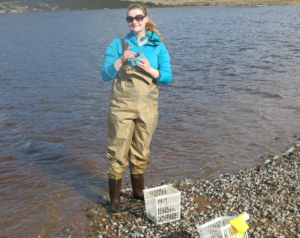The Environmental Information: Use and Influence research program has had a long affiliation with the Gulf of Maine Council on the Marine Environment (GOMC) through preparation of bibliographies of the GOMC publications (Cordes et al, 2006; Ross et al., 2014), evaluation of the use and influence of that literature (Cossarini et al., 2014; MacDonald et al., 2007; Soomai et al., 2013), as well as one member (myself) being a member of the Working Group of the Council and Co-Chair of its Gulfwatch monitoring sub-committee. In addition, one of the graduate students in the team studied the use of the Gulfwatch contaminants monitoring information by the Province of Nova Scotia, a member of the GOMC (Chamberlain & Wells, 2014; Chamberlain et al. 2018).
Photo credit: Sarah Chamberlain mussel sampling in the Bay of Fundy region (P. G. Wells)
Recently, I collaborated with four Americans and a Canadian colleague to compare the utility of Blue Mussels and sediments for characterizing the presence, and spatial and temporal levels of several classes of chemicals in the Gulf. This effort over the past two years resulted in a paper just published in Marine Pollution Bulletin (Elskus et al., 2020).
In short, the analyses of extensive data sets from four coastal monitoring programs has shown that “mussel contaminant data are likely sufficient for providing information on the spatial and temporal distribution of contaminants in coastal waters, under a broad range of environmental conditions and contaminant levels, and unlike sediments, provide direct information on contaminant bioavailability.” Chemical analyses are costly and time consuming, so any effort to focus field sampling, in this case making the choice between mussels and local sediments, reduces costs and enhances the overall value of the data. Information on the contamination of mussels is valuable for assessing both marine ecosystem health and human health.
Hence, this paper presents policy implications for wide scale monitoring programs – for several classes of organic contaminants of concern, especially, legacy chemicals such as PAHs and PCBs. Mussel monitoring provides the required data for marine managers responsible for pollution control and protection of human health. Sediment sampling is not critical as a routine method but can be conducted in low energy depositional environments for historical records of contamination. This perspective has significant cost implications for coastal monitoring. The monitoring collaboration and resulting paper are another example of the close connection between science and policy development in marine environmental protection, and the continued contributions of the EIUI program to the mission of the Gulf of Maine Council of protecting both the environment and human health.
Elskus, A. A., LeBlanc, L. A., Latimer, J. S., Page, D. S., Harding, G. C. H., & Wells, P. G. (2020). Monitoring chemical contaminants in the Gulf of Maine, using sediments and mussels (Mytilus edulis): An evaluation. Marine Pollution Bulletin, 153, 10956. doi: https://doi.org/10.1016/j.marpolbul.2020.110956
Abstract: The objective of this paper is to determine whether contaminant data on mussels and sediments can be used interchangeably, or not, when assessing the degree of anthropogenic contamination of a water body. To obtain adequate coverage of the entire Gulf of Maine, Bay of Fundy sediment samples were collected, analyzed and combined with similar data from four coastal monitoring programs. This required careful interpretation but provided robust results consistent with published literature. A strong correspondence was found between sediment and mussel concentrations for polycyclic aromatic hydrocarbons, moderate to weak correspondence for polychlorinated biphenyls, and except for mercury and zinc, little to no correspondence was found for metals. We conclude that mussel contaminant data are likely sufficient for providing information on the spatial and temporal distribution of chemical contaminants, in coastal waters, under a broad range of environmental conditions and contaminant levels, and unlike sediments, provide direct information on contaminant bioavailability.
References
Chamberlain, S. D., & Wells, P. G. (2014). Bibliography of publications related to the Gulfwatch contaminants monitoring program. Halifax: Environmental Information: Use and Influence, Dalhousie University.
Chamberlain, S. D., Wells, P. G., & MacDonald, B. H. (2018). The Gulfwatch contaminants monitoring program in the Gulf of Maine: Are its data being used for ocean protection, with special reference to Nova Scotia, Canada? Marine Pollution Bulletin, 127, 781-787. http://dx.doi.org/10.1016/j.marpolbul.2017.09.050
Cordes, R. E., MacDonald, B. H., & Wells, P. G. (2006). Publications of the Gulf of Maine Council on the Marine Environment and their use. A report submitted to the Gulf of Maine Council on the Marine Environment. Halifax, June 2006. Retrieved from http://www.gulfofmaine.org/council/publications/GOMCpublications-report-Cordes-2006.pdf
Cossarini, D. M., MacDonald, B. H., & Wells, P. G. (2014). Communicating marine environmental information to decision makers: Enablers and barriers to use of publications (grey literature) of the Gulf of Maine Council on the Marine Environment. Ocean & Coastal Management, 90, 163-172. https://doi.org/10.1016/j.ocecoaman.2014.05.015
Elskus, A. A., LeBlanc, L. A., Latimer, J. S., Page, D. S., Harding, G. C. H., & Wells, P. G. (2020). Monitoring chemical contaminants in the Gulf of Maine, using sediments and mussels (Mytilus edulis): An evaluation. Marine Pollution Bulletin, 153, 10956. doi: https://doi.org/10.1016/j.marpolbul.2020.110956
MacDonald, B. H., Cordes, R. E., & Wells, P. G. (2007). Assessing the diffusion and impact of grey literature published by international intergovernmental scientific groups: The case of the Gulf of Maine Council on the Marine Environment. Publishing Research Quarterly, 23(1), 30-46. doi: 10.1007/s12109-007-9010-6
Ross, J. D., Hubbard, D., Cordes, R. E., MacDonald, B. H., & Wells, P. G. (2014, February). Celebrating 25 years of knowledge on the Gulf: A Bibliography of publications of the Gulf of Maine Council on the Marine Environment. Halifax: Environmental Information: Use and Influence, Dalhousie University.
Soomai, S. S., MacDonald, B. H., & Wells, P. G. (2013). Communicating environmental information to the stakeholders in coastal and marine policy-making: Case studies from Nova Scotia and the Gulf of Maine/Bay of Fundy region. Marine Policy, 40, 176-186. https://doi.org/10.1016/j.marpol.2013.01.017
Author: Peter G. Wells
